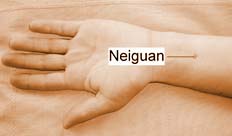

Acupoint | Acupressure | Acupunture treatment for Acid Reflux
Acupressure is the field of traditional Chinese medicine in which pressure is applied by hand to the same acupoints where needles would be inserted for acupuncture treatments. Electrical acupoint stimulation is a high-tech version of the traditional acupuncture procedure. By applying pressure to the acupoints prescribed by ancient Chinese charts, specific organs and areas of the body may be successfully treated using the energy of the meridian system called Yin. Yang and Qi are brought into alignment, allowing the body to heal itself.
At Australia's University of Adelaide, researchers applied a mild electrical pulse to stimulate an acupressure point on the wrist known as Neiguan or Pericardium 6 (P6), which is associated with upper gastrointestinal conditions such as acid reflux.
The acupoint stimulation reduced relaxations of the lower esophageal sphincter (LES). Relaxation of the LES is the major cause of acid reflux. This stimulation reduced transient lower esophageal sphincter relaxations (TLESRs) by a surprising 40% from 6 an hour to just to two and a half an hour. It was also significantly higher than the placebo group, which received “sham” stimulation on the hip.
"It was an out-of-left-field approach, without any real expectations that it might work," according to Richard H. Holloway, in whose Royal Adelaide Hospital laboratory the work was done, "but we had well-defined technology and measurements for studying GERD." The protocol utilized electrical acupoint stimulation, a high-tech type of acupuncture, with a GERD model imposed on normal subjects by inflating a balloon in their stomachs.
Holloway said that LES relaxations have become "an area of great interest" in drug industry research. But his team's findings, published in the American Journal of Physiology-Gastrointestinal and Liver Physiology, point to the potential of the 2,000-year-old practice of acupuncture.
The acupoint stimulation used in Holloway's study is a modern twist on the ancient procedure. In place of needles, acupoint uses electrodes to send a small electrical pulse to specific acupuncture points on the skin. According to traditional Chinese medicine, these points are connected to internal pathways that conduct energy throughout the body; stimulation of these points is thought to promote a healthy flow of energy (chi). Allopathic medicine is just beginning to understand these principals, suggesting that acupuncture functions by altering the way that nerve cells signal one another, and can influence the way the central nervous system releases certain chemicals in the body. It is the recent study, though, that is the first to give evidence that it can, indeed, benefit the function of the lower esophageal sphincter. Given time, modern medical science may eventually catch up with these ancient healing methods.
Acupuncture has long been used in traditional medicine to treat stomach ailments, Holloway said, but until now there had been no evidence that acupoint stimulation affects LES relaxations. Still, the reason for the LES effects is "completely unclear". Holloway and his colleagues had speculated that acupoint stimulation might prevent LES relaxations by affecting the body's release of endorphins or other pain-killing chemicals called enkephalins. But in a second experiment, where volunteers received a medication that blocks these chemicals, acupoint stimulation still reduced LES relaxations.
Holloway described the findings as "very preliminary," in that they showed only that LES relaxations declined during acupoint stimulation. The remaining, and significant questions are whether the effects last once the procedure is over—and whether they will in fact prevent acid reflux. An important next step will be to see whether acupoint stimulation reduced acid reflux after a meal. Despite the early promise, Holloway noted, heartburn sufferers should hold off on making that acupuncture appointment just yet.

Acupressure to the P6 has been employed for years to relieve nausea, vomiting, motion and sea sickness, morning sickness in pregnant women and post operative nausea. It is also used to treat fever, insomnia, epilepsy, migraine and chest pain. Acupressure wrist bands, also called "sea bands", are now being used for this purpose. The wrist band fits snugly on the wrist and has a small plastic button which applies pressure to the P6. It is now believed that these same wrist bands may reduce acid reflux.
You can also just use your fingers to apply pressure to the P6. Acupoints are normally beside and in between bones, ligaments and tendons. They are never found on bones, blood vessels or arteries, but in depressions between or beside them.
By Mortin - Copyright 2009
Last modification 31/12/2009
Source: American Journal of Physiology-Gastrointestinal and Liver Physiology, August 2005 by Dr. Duowu Zhou, Wei Hao Chen, Katsuhiko Iwakiri, Rachael Rigda, Marcus Tippett and Richard H. Holloway of the Royal Adelaide Hospital, Australia.


Custom Search
Acid Reflux
Heartburn
GERD
Indigestion
Tools & Resources
![]() This site complies
This site complies
with the HONcode standard for trustworthy health information:
verify here.
